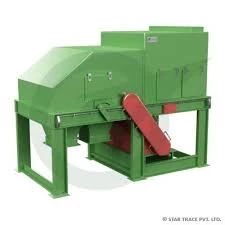

11-р сар . 19, 2024 00:09 Back to list
Understanding the Working Principle of Eddy Current Separators
Eddy current separators play a crucial role in the field of recycling and waste management, providing an effective solution for the separation of non-ferrous metals from various materials. The working principle of these devices is based on electromagnetic induction and the phenomenon of eddy currents, allowing for efficient material recovery and processing.
The Basics of Eddy Currents
The concept of eddy currents was first discovered by the physicist Heinrich Lenz in the 19th century. When a conductor is exposed to a changing magnetic field, it experiences a change in magnetic flux, which induces circular electric currents—known as eddy currents—within the conductor. These currents produce their own magnetic fields that oppose the original magnetic field, resulting in forces that can separate materials based on their conductivity and density.
Components of an Eddy Current Separator
An eddy current separator typically consists of several key components 1. Magnetic Drum This is the core component that creates the alternating magnetic field essential for inducing eddy currents in non-ferrous metals. 2. Feeder System A conveyor belt system that transports mixed materials towards the separator. 3. Control System This regulates the speed and intensity of the magnetic field to optimize separation efficiency. 4. Discharge Chutes These guide the separated materials into different collection bins, allowing for convenient sorting and processing.
The Separation Process
The operation of an eddy current separator can be broken down into several steps
1. Feed Material Mixed materials, including metals, plastics, and other waste, are fed onto the conveyor belt. The design of the belt allows for a uniform distribution of the materials as they pass over the separation area.

2. Magnetic Induction As the conveyor belt approaches the magnetic drum, it enters a region of a strong alternating magnetic field. The magnetic field induces eddy currents in any non-ferrous metallic objects present.
3. Creation of Repulsive Forces The eddy currents generate their own magnetic field, which interacts with the original magnetic field from the magnetic drum. Depending on their orientation, these fields create repulsive forces that act on the non-ferrous metals, causing them to be propelled away from the conveyor belt and into a separate discharge chute.
4. Separation of Materials As non-ferrous metals (like aluminum, copper, and brass) are repelled, they are directed into one collection bin, while other materials, such as ferrous metals and non-metallic waste, continue along the conveyor belt to be processed differently.
Advantages of Eddy Current Separators
Eddy current separators offer several significant advantages, making them an invaluable tool in recycling and waste management
- Efficiency These devices can separate materials with high precision, ensuring that valuable non-ferrous metals are effectively recovered, which can be reused in manufacturing processes. - Reduced Labor Costs Automating the separation process minimizes the need for manual sorting, reducing labor costs and increasing overall productivity. - Environmentally Friendly By recovering and recycling valuable metals, eddy current separators contribute to sustainable practices, helping reduce the environmental impact of mining and resource depletion. - Versatility These separators can handle a wide range of materials and can be integrated into various recycling systems, making them adaptable to different industrial needs.
Conclusion
The working principle of eddy current separators is a prime example of how electromagnetic induction can be harnessed for practical applications, particularly in recycling and waste management. By effectively separating non-ferrous metals from waste streams, these devices not only enhance material recovery processes but also promote sustainability and efficiency in resource management. As technology advances, the capabilities and applications of eddy current separators are likely to expand, furthering their role in modern recycling efforts.
Latest news
Troubleshooting Common Eddy Separator Problems
NewsJul.04,2025
The Role of Metal Recycling Plants in Circular Economy
NewsJul.04,2025
The Impact of Recycling Line Pickers on Waste Management Costs
NewsJul.04,2025
Safety Features Every Metal Shredder Should Have
NewsJul.04,2025
How Industrial Shredders Improve Waste Management Systems
NewsJul.04,2025
How Cable Granulators Contribute to Sustainable Recycling
NewsJul.04,2025